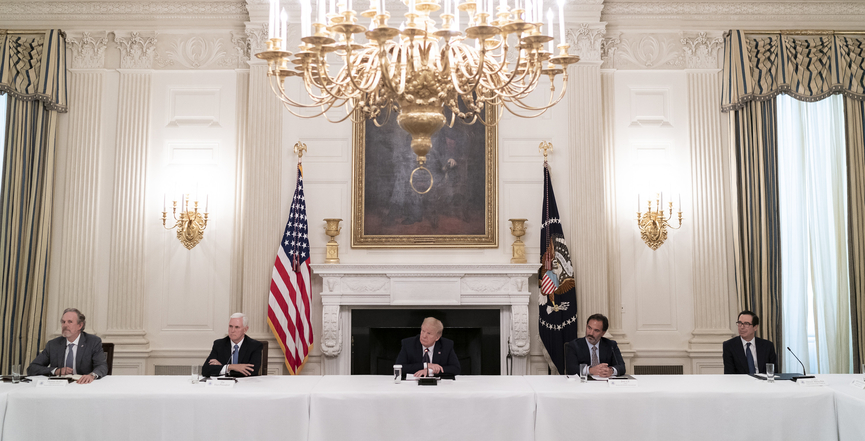The U.S. has intensified its cold war with China.
U.S. President Donald Trump wants the blame for the American death toll from the coronavirus pandemic — estimated to exceed 100,000 before the end of May — to be laid at the door of China. He called the virus “the worst attack we’ve ever had on our country … worse than Pearl Harbor … worse than the World Trade Center” and said: “Could’ve been stopped in China … And it wasn’t.”
The American president threatens to leave the World Health Organization, accusing it of hiding Chinese responsibility for the pandemic.
Vigorous, outspoken diplomacy has characterized the Chinese response to international criticism of its failure to identify quickly and halt the international spread of COVID-19.
Nicknamed the “wolf warriors,” Chinese ambassadors are intervening aggressively to counter accusations of China supplying faulty personal protection equipment (PPE) or falsifying data about the impact of the virus on China, or simply to set the record straight when criticized by public officials (as Alberta Premier Jason Kenney discovered when the Chinese consulate general in Calgary replied harshly to his denunciations).
Whatever the level of the rhetoric and the seriousness of the underlying conflict dividing the world’s two largest economies, what drives current American policy towards China is the next presidential election.
With six months remaining to secure re-election, Trump faces multiple questions about his bungling leadership as American officials responded to the pandemic.
The Trump economic record now reads recession today, with fears of a depression tomorrow. Employment has collapsed; the stock market plummeted; and armed protestors have invaded the Michigan state legislature calling for economic life to resume as before the COVID-19 restrictions.
When explaining away domestic chaos becomes difficult, a standard ploy for a super power is to single out a foreign enemy to blame. For Trump, China fits the bill.
Since the U.S. “lost China” after the 1949 revolutionary takeover by the Communist party, the U.S. and China were at war in Korea from 1950 to 1953, sponsored and waged a proxy war in Vietnam from 1954 to 1975, and were only able to normalize relations in 1972, when U.S. president Nixon adopted a geopolitical strategy designed to move China away from Russia.
Dangerously for the world economy, the Trump administration began a tariff war with China that was expanded to include virtually all the practices of foreign trade and investment that have governed the integration of the two economies in the last two decades.
A vast number of U.S. corporations have factories and locations manufacturing products in China.
With the Western world discovering its dependence on Chinese production for PPE such as surgical masks and gloves, American law-makers are calling on government subsidies to repatriate production to the U.S.
After ordering American companies last year to cease supplying goods to Huawei, the Chinese telecommunications giant, the U.S. administration moved to tighten its control by forbidding companies anywhere the use of American technology to supply semi-conductors to Huawei.
In reprisal, China has threatened to put American tech champions with major Chinese operations — companies such as Apple, Cisco and Qualcomm — on a list of “unreliable” entities and “nuke bomb” them with endless investigation.
The Chinese leadership has successfully fanned nationalist emotion as it responds to the tariff war started by the Trump administration. However, Chinese “leader for life” Xi Jinping has done serious damage to his international standing through his regime’s brutal suppression of Hong Kong demonstrators, which has surely not gone unnoticed throughout China.
Continued public support for the Chinese authoritarian surveillance state depends on economic growth and shared prosperity. The middle class that now numbers between 500 and 700 million expects the state to do a better job protecting its citizens than the Xi Jinping regime did facing the pandemic.
After initially rejecting demands for a WHO inquiry into the origins of COVID-19, China has reversed course and accepted to co-sponsor a World Health Assembly resolution calling on the WHO director-general to organize such a study.
In an effort to shore up its international image, the Chinese leader promised that when China developed and produced a vaccine to treat COVID-19 it would be distributed as an international public good.
Not to be discounted simply because they are led by a president viewed with disdain the world over, “America first” political forces are in ascendency today in Washington, D.C. and significant U.S. business circles.
“America first” represents a return to long standing “isolationist” tendencies in U.S. foreign policy. Isolationism translates into aggressive American nationalism that exerts pressures not just on China, or Russia, but on countries that think of themselves as U.S. allies in Europe, Asia and the Americas.
In the absence of a China-U.S. bilateral (G2) understanding to dial back cold war escalation, the easing of international tensions would in normal times be the job of international institutions such as the UN, the G20 and the World Trade Organization.
As the world should have learned by now, Trump times are not normal times.
Duncan Cameron is president emeritus of rabble.ca and writes a weekly column on politics and current affairs.
Image: The White House/Flickr




